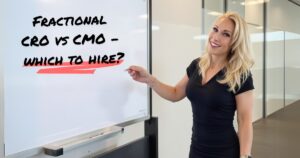Sales enablement adoption has increased 343% in the past five years. Along with that explosion in growth has come a lot of confusion and misconceptions about what sales enablement is — and isn’t.
Simply put, sales enablement can be any tool that helps enable sales. That might be landing pages, case studies, or even an email workflow in this context. Because of this, it’s easy to group them into the marketing category.
However, that’s not entirely accurate. While sales enablement is a function of sales, it’s not uncommon for marketing to create some of the tools. This shared effort is where the line blurs and the confusion begins.
In this article, we will delve into the definitions, roles, and key components of both sales enablement and marketing, as well as explore the similarities and differences between the two. We’ll examine the interplay between sales enablement and marketing, and discuss effective implementation strategies.
By the end, you will clearly understand each discipline’s unique contributions and how they can work together harmoniously to drive your business forward.
What is Sales Enablement?
At its core, sales enablement encompasses all the tools, processes, and strategies that empower sales teams to effectively engage with customers, ultimately increasing sales and revenue.
It involves equipping sales representatives with the resources they need to better understand products or services, communicate their value proposition, and address potential customer concerns.
Sales enablement aims to bridge the gap between marketing and sales, ensuring a seamless customer experience from the initial contact to the final purchase decision.
The Role of Sales Enablement in Business
Sales enablement is crucial in driving revenue growth and achieving business objectives. Businesses can enhance their customer interactions and build long-lasting relationships by providing sales teams with the necessary knowledge and training.
As per Aberdeen, successful sales enablement programs help achieve 32% higher team sales quotas and 24% better individual quotas.
Additionally, sales enablement ensures that the sales process aligns with the organization’s overall strategy, optimizing resource use and profitability. Access to tools is a top priority, considering 81% of sales and executives have cited content search and utilization as their top productivity improvement area.
It also allows for the identification of trends, customer preferences, and potential opportunities, enabling businesses to stay ahead of the competition. After all, optimizing and improving your operations is only possible if you know what’s working and what isn’t.
Key Components of Sales Enablement
Successful sales enablement relies on several key components that work together to streamline sales processes and foster success. These include:
- Training and Development: Equipping sales teams with product knowledge, sales techniques, and customer engagement strategies is paramount to their effectiveness. Ongoing training and development programs ensure that sales representatives are up-to-date with industry trends and equipped to overcome challenges.
- Content Creation and Management: Providing sales teams with high-quality sales collateral and tools allows them to effectively communicate the value of products or services to potential customers. Regularly updating and managing content ensures that sales representatives have access to the most relevant and up-to-date materials.
- Sales Process Optimization: Mapping out the sales process and identifying areas for improvement allows businesses to streamline operations and enhance efficiency. By reducing unnecessary steps and implementing automation where possible, sales teams can focus more on building relationships and closing deals.
- Collaboration and Communication: Facilitating collaboration between sales, marketing, and other departments encourages knowledge sharing and aligns goals for a more seamless customer experience. Open lines of communication ensure that sales representatives are equipped with the most accurate and timely information to effectively engage with customers.
What is Marketing?
Marketing encompasses a wide range of activities to promote products or services, generate leads, and increase brand visibility. It involves strategic planning, market research, messaging, and communication efforts to attract, engage, and retain customers.
Marketing is pivotal in creating brand awareness, cultivating customer loyalty, and driving demand for products or services.
The Purpose of Marketing in Business
The purpose of marketing in business is multifaceted. It creates and maintains brand awareness, establishes the unique value proposition of products or services, and generates demand. Companies can attract and retain loyal customers by effectively communicating the benefits and advantages of their offerings.
Marketing also facilitates market research and analysis, enabling businesses to identify target audiences, understand their preferences, and tailor their offerings accordingly. Ultimately, marketing plays a vital role in driving revenue growth and fostering long-term business success.
Essential Elements of Marketing
A successful marketing strategy comprises several essential elements that work together to achieve business objectives. These include:
- Market Research: Conducting thorough market research allows businesses to gain insights into customer preferences, market trends, and competitors. This information is the foundation for developing effective marketing campaigns and strategic decision-making.
- Messaging and Positioning: Developing a clear and compelling brand message and positioning statement helps differentiate businesses from competitors and resonates with target audiences. Effective messaging conveys the unique value proposition of products or services and creates strong brand associations.
- Marketing Channels: Identifying and utilizing the most suitable marketing channels to reach target audiences is crucial. Whether through social media, email marketing, content marketing, or traditional advertising, businesses must choose the channels that align with their target customers’ preferences.
- Integrated Marketing Campaigns: Coordinating marketing efforts across multiple channels and touchpoints maximizes campaign impact and ensures consistent messaging and branding. Integrated marketing campaigns generate greater reach and engagement, increasing brand visibility and customer acquisition.
Comparing Sales Enablement and Marketing
While sales enablement and marketing share the common goal of driving business growth, they differ in their focus and approach. Understanding these differences is essential for leveraging the strengths of each discipline and fostering collaboration between the two.
Similarities Between Sales Enablement and Marketing
Both sales enablement and marketing aim to enhance customer engagement, generate revenue, and contribute to overall business success. They both require a deep understanding of customer’s needs and preferences and involve developing strategies tailored to target audiences. Both disciplines rely on data analysis and insights to inform decision-making and measure success.
Distinct Differences Between Sales Enablement and Marketing
Despite their similarities, sales enablement and marketing have distinct focuses and responsibilities within a business:
1. Sales Enablement: Sales enablement primarily focuses on equipping sales teams with the necessary tools, training, and resources to effectively engage with customers and close deals. Success is measured by revenue generated, customer satisfaction, and sales performance metrics.
2. Marketing: Marketing encompasses a broader range of activities, including market research, branding, lead generation, and campaign execution. It aims to generate awareness, interest, and desire for products or services, ultimately driving customer acquisition and retention. Marketing success is evaluated based on brand visibility, lead quality, and customer engagement metrics.
The Interplay Between Sales Enablement and Marketing
Recognizing the interplay between sales enablement and marketing is crucial for maximizing their impact and aligning their efforts.
How Marketing Contributes to Sales Enablement
Marketing plays a pivotal role in contributing to sales enablement by developing targeted campaigns, generating high-quality leads, and creating compelling marketing collateral. By conducting market research and understanding customer needs and preferences, marketing teams can provide valuable insights that inform the sales enablement process.
Marketing strategies and content ensure sales representatives have relevant and engaging materials to effectively engage and convert potential customers into sales. Furthermore, marketing analytics and performance data help identify trends, market opportunities, and sales enablement areas for improvement.
How Sales Enablement Contributes to Marketing
At its core, marketing should support sales. Flashy brochures and brand awareness campaigns can only get you so far. For a business to survive, you need to have a solid ROI on your marketing efforts.
Sales can contribute to marketing by helping connect the dots. A strong attribution strategy can solve John Wanamaker’s adage, “Half the money I spend on marketing is wasted; the trouble is I don’t know which half.” Once marketing knows which campaigns and strategies are paying off, they can optimize and focus on creating more of the same.
Another way sales can help support marketing is by communicating the objections they receive, sharing the questions they get during sales calls, and feedback from the prospects about what messaging compelled them to jump on a call. This insight is critical for creating marketing campaigns that directly convert to sales and ensure everyone keeps their paycheck.
Implementing Sales Enablement and Marketing Strategies
Successfully implementing sales enablement and marketing strategies requires careful planning, effective execution, and continuous evaluation. By following best practices in each discipline, businesses can optimize their sales and marketing processes and achieve sustainable growth.
Best Practices for Sales Enablement
- Collaboration and Alignment: Foster collaboration between sales, marketing, and other relevant departments to ensure alignment of goals and strategies. Creating cross-functional teams and maintaining open lines of communication facilitates knowledge sharing and enhances the overall customer experience.
- Continuous Training and Development: Provide sales teams with ongoing training and development opportunities to ensure they’re equipped with the latest product knowledge, sales techniques, and customer engagement strategies. Regularly evaluate training effectiveness and modify programs as needed.
- Analytics and Performance Measurement: Establish key performance indicators (KPIs) to track the effectiveness of sales enablement initiatives. Regularly analyze performance data to identify areas for improvement and inform decision-making.
- Content Management: Develop a centralized content management system that allows sales representatives to easily access relevant sales collateral and marketing materials. Regularly update and refine content based on customer feedback and sales team insights.
As sales enablement continues to gain traction, understanding the interplay between sales and marketing helps ensure successful business strategies. While sales enablement equips sales teams with the tools and resources to effectively engage with customers, marketing focuses on generating awareness and driving demand for products or services.
By leveraging the strengths of each discipline and fostering collaboration, businesses can optimize their sales and marketing processes, leading to increased revenue, customer satisfaction, and long-term success.







